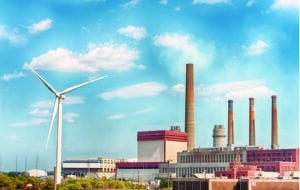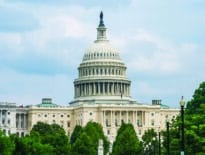
An experimental wind turbine on the Boston-Everett line stands next to Everett’s now-decommissioned coal-fired power station in 2016. iStock photo
Massachusetts needs a major rethink of its plans to transition to a clean energy future.
If we don’t, the gap between what’s being promised by our elected leaders – slashing our carbon emissions in half by 2030 – and what’s feasible will only grow increasingly untenable.
“Between now and the long run, we have to deal with what’s real,” Paul Levy, former head of the state’s Department of Public Utilities, told me last week during a forum I organized for the newsletter I publish, Contrarian Boston.
Right now, there are a lot of things happening seemingly all at once: a backlash against soaring electric and gas bills as the cost of renewable energy programs rises; concerns raised by developers and builders about strict new energy codes that make housing, already hard to build, even harder; and a tenuous outlook for the off-shore wind industry, long the centerpiece of the Bay State’s plans to generate the clean electricity needed to decarbonize our grid.
The Dirty Little Secret’s Out
While all these problems have been brewing for a while, it was the backlash against soaring gas and electric bills that set off what is fast becoming a deluge of discontent and disillusionment with our state’s energy transition plans.
A surge in electric and gas bills over the winter triggered a consumer and voter backlash that prompted Gov. Maura Healey and state lawmakers to take action.
While a spate of very cold weather was partly to blame, a bigger factor was the Mass Save energy efficiency program, which played a significant role, over the past two years, in the driving up electric delivery rates by more than 30 percent, and gas delivery charges by nearly 38 percent, according to a WCVB-TV report.
Mass Save, which helps pay for home insulation, residential heat pumps and a myriad of other energy transition programs, is paid for itself through a surcharge on utility ratepayers’ bills.
And that, in turn, highlights the dirty little secret of the clean energy transition in Massachusetts: Effectively, gas and utility ratepayers have been on the hook for paying for it
It’s a system that worked as long as those seemingly obscure and hard-to-understand charges were low enough to escape attention.
But that’s clearly no longer the case.

Senate President Karen Spilka and House Speaker Ron Mariano stand at a Juneteenth celebration at the State House on June 18, 2025. Speaking to the Greater Boston Chamber of Commerce in April, Mariano declared that new clean energy policies will “have to be justified.” Photo by Ella Adams | State House News Service
Facing reelection next year, Healey’s response was to lower those charges by lopping off $500 million from the $5 billion Mass Save program.
That has worked to calm down public discontent, but putting the entire cost of the energy transition on ratepayers is clearly an unsustainable proposition, and top lawmakers and the governor likely know that.
Healey has also proposed giving the state the flexibility to shift energy transition costs out of utility bill surcharges and onto the state’s ledger, Lexington state Sen. Michael Barrett told me last week at my Contrarian Boston forum.
Barrett believes the proposal, which would allow the state to float bonds to pay for some of these projects, is likely to make it through the Legislature.
Whether voters and taxpayers will go for these energy transition programs when they are out in the open – and not folded into seemingly electric bill charges – is another matter.
We’re Killing New Housing
Massachusetts now faces challenges to its energy transition plans in two other, very significant areas as well.
Let’s start with the new energy codes and no-natural gas mandates the state and some municipalities like Boston and Newton have placed on new development.
Developers, contractors and industry groups contend that the extra upfront costs make both new homes and new rental housing more expensive and therefore harder to build now that construction loan costs have skyrocketed.
The state’s new so-called “stretch” energy code, which towns and cities across Massachusetts are increasingly adopting, has the potential of slapping anywhere from $10,000 to $23,000 onto the cost of building a new single-family home or townhouse,
That’s according to a 2023 study by MIT and Wentworth Institute of Technology researchers commissioned by the Home Builders and Remodelers Association of Massachusetts.

Scott Van Voorhis
Let’s Have a Real Debate
And now, the centerpiece of the state’s plans to generate electricity for all those new heat pumps and all-electric apartment buildings – offshore wind – is looking increasingly shaky.
After years of talk and planning, just one offshore wind farm, Vineyard Wind, has been built, and it’s had a rocky start after problems with turbine blades, including one that broke off and left fiberglass shards on the beaches of Nantucket.
With Trump a sworn enemy of off-shore wind – and the industry already facing serious inflation-related challenges before that – it seems highly unlikely we will see any additional wind farms built in the next five to 10 years.
Certainly, there are a lot of issues Massachusetts needs to grapple with.
However, until the last few months, we haven’t had a real debate over the necessary balancing act between how fast we decarbonize our energy systems and how we do it without killing housing development or making the state too expensive a place to do business – or even live in.
Now, with cost of Massachusetts’ transition plans finally too high to ignore, the debate is on and it’s anyone’s guess how it will all shake out.
Scott Van Voorhis is Banker & Tradesman’s columnist and publisher of the Contrarian Boston newsletter; opinions expressed are his own. He may be reached at sbvanvoorhis@hotmail.com.






